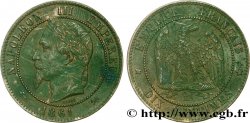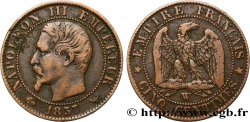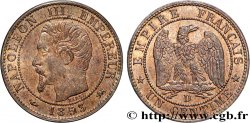v42_0762 - 5 francs or Napoléon III, tête nue, petit module, tranche cannelée 1854 Paris F.500A/1
MONNAIES 42 (2010)
Starting price : 150.00 €
Estimate : 200.00 €
Realised price : 171.00 €
Number of bids : 2
Maximum bid : 172.00 €
Starting price : 150.00 €
Estimate : 200.00 €
Realised price : 171.00 €
Number of bids : 2
Maximum bid : 172.00 €
Type : 5 francs or Napoléon III, tête nue, petit module, tranche cannelée
Date: 1854
Mint name / Town : Paris
Quantity minted : 2870170
Metal : gold
Millesimal fineness : 900 ‰
Diameter : 14,26 mm
Orientation dies : 6 h.
Weight : 1,60 g.
Edge : cannelée
Coments on the condition:
Légères traces de nettoyage et des petites marques de manipulation dans les champs. La monnaie est bien frappée et bien centrée
Catalogue references :
Obverse
Obverse legend : NAPOLEON III EMPEREUR.
Obverse description : Tête nue de Napoléon III à droite ; au-dessous (différent) BARRE (différent), le long du listel.
Reverse
Reverse legend : EMPIRE FRANCAIS.
Reverse description : 5 / FRANCS, en deux lignes dans le champ, au-dessus de 1854, dans une couronne composée de deux branches de laurier nouées en bas ; sous le nœud, la lettre d'atelier A.
Commentary
Ce type a toujours été rare car les pièces ont été largement refondues avant leur démonétisation par le décret du 19 février 1859. Par décision ministérielle en date du 14 juillet 1855, la Banque de France a versé au change pour être refondues les pièces de 5 francs en or de 14 mm pour une valeur de 4.440.000 francs soit 888.000 pièces.








 Report a mistake
Report a mistake Print the page
Print the page Share my selection
Share my selection Ask a question
Ask a question Consign / sell
Consign / sell
 Full data
Full data









